Navigating the AI Content Revolution
As a small business owner, you may have been led to believe that AI would simplify your content marketing efforts. However, with the influx of AI-generated content, standing out has become more challenging than ever. This blog explores the pitfalls of relying solely on AI and offers strategies to leverage it effectively for your business’s success.
The Promise of AI in Content Marketing
When AI tools like ChatGPT emerged, the promise was enticing. Small business owners were told they could generate high-quality content effortlessly, allowing them to focus on other critical aspects of their business. The idea was that AI would streamline content creation, making it easier to attract customers and grow the brand.
However, this promise came with a caveat. While AI can produce content quickly, the quality and uniqueness often suffer. As more businesses adopted these tools, the digital landscape became saturated with generic, repetitive content. This raises the question: How can small business owners like you navigate this new reality?
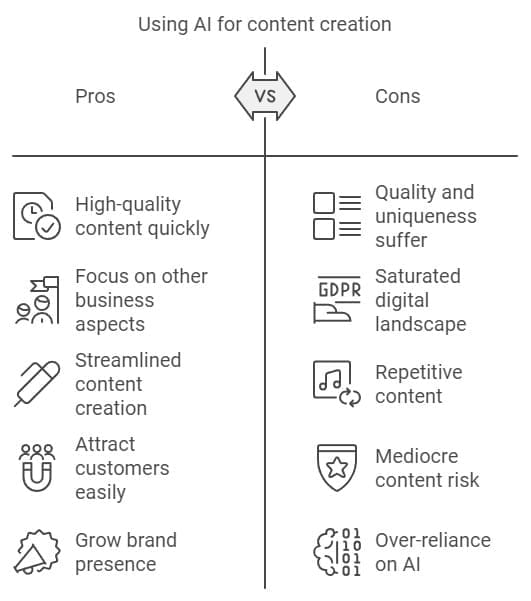
Using AI for content creation
Key Benefits of AI in Content Marketing
- Time Savings: AI can drastically reduce the time spent on content creation, allowing you to focus on other areas of your business.
- Cost Efficiency: Using AI tools can minimize the need for hiring additional staff or freelancers, keeping your overhead low.
- Data-Driven Insights: AI can analyze consumer behavior and preferences, helping you tailor your content to meet your audience’s needs.
The Reality Check: Everyone’s Using AI
The reality is that you’re not alone in leveraging AI for content marketing. Your competitors are likely using similar tools to create their content. This widespread adoption has led to a homogenization of digital content, where many businesses sound alike. Standing out in a crowd of AI-generated content is now more challenging than ever.
So, how do you ensure your content remains relevant and engaging? It’s crucial to focus on authenticity and value. Instead of relying solely on AI, consider integrating your unique voice and perspective into your content strategy. This can help differentiate your brand from the competition.
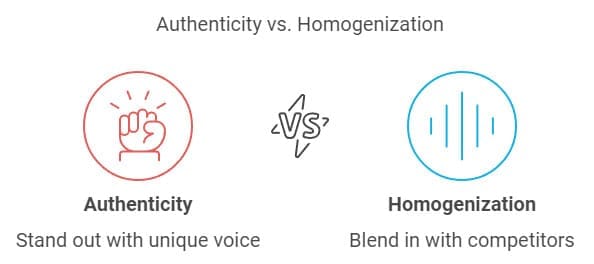
Authenticity vs. Homogenization
Strategies for Standing Out
- Incorporate Personal Stories: Share your experiences and insights that only you can provide.
- Engage with Your Audience: Ask for feedback and create content that addresses their specific questions and concerns.
- Focus on Quality Over Quantity: Prioritize well-researched and thoughtfully crafted content rather than churning out posts just for the sake of it.
The Consequences of Mediocre Content
As the internet fills with mediocre AI-generated content, the consequences for small businesses can be severe. Poor-quality content can lead to disengagement, higher bounce rates, and ultimately, a loss of customers. When users encounter generic content, they’re less likely to trust your brand or return for more.
Moreover, search engines are getting smarter. They can recognize low-quality content and may penalize sites that rely heavily on AI-generated material. This means that your visibility could take a hit, making it even harder to attract new clients.
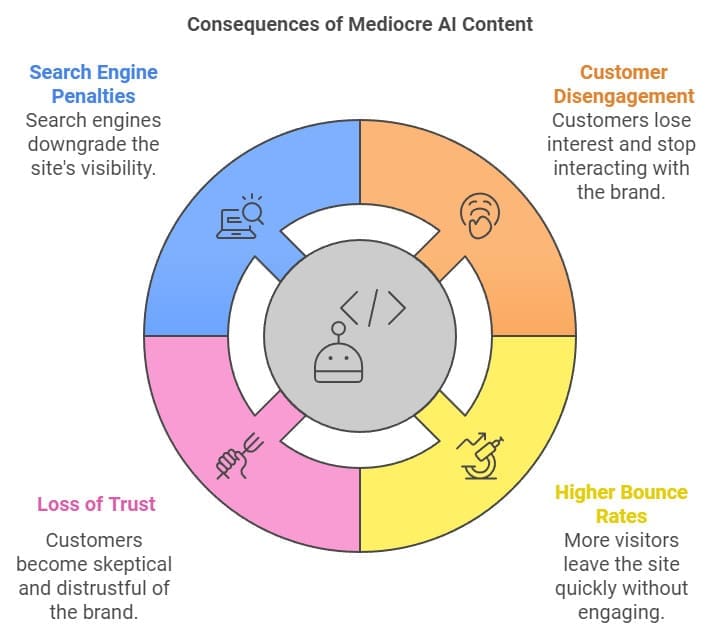
Consequences of Mediocre AI Content
Identifying Mediocre Content
- Repetitive Themes: If your content echoes what’s already out there without adding new insights, it may come off as mediocre.
- Low Engagement: Check metrics like comments and shares; low engagement often indicates that your content isn’t resonating.
- Poor Grammar and Structure: AI-generated content can sometimes be riddled with mistakes, which can damage your credibility.
Understanding the Risks of Over-Reliance on AI
While AI can be a powerful tool, over-relying on it can lead to significant risks. One major concern is the loss of your brand’s unique voice. When you depend too heavily on AI, your content may start to sound robotic or impersonal, which can alienate your audience.
Additionally, AI lacks the human touch that makes content relatable. It can’t understand nuances or emotions the way you can. This is particularly important in building relationships with your customers. Trust and authenticity are key to long-term success, and AI alone cannot deliver that.

How much do you depend on AI?
Balancing AI Use and Human Touch
- Use AI for Drafting: Let AI assist with brainstorming or drafting, but ensure you personalize and refine the content.
- Incorporate Feedback: Use customer feedback to guide your content strategy and ensure it meets their needs.
- Stay Informed: Keep learning about content trends and AI capabilities to use them effectively without losing your unique voice.
Turning the Tables: Using AI to Your Advantage
Despite its pitfalls, AI can still be a game-changer when used strategically. By leveraging AI for mundane tasks, you can free up valuable time to focus on creative and strategic initiatives. Consider using AI for data analysis, social media scheduling, or even generating content ideas.
Moreover, combining AI with your insights can create a powerful synergy. Use AI-generated data to understand market trends, and then craft content that speaks to those trends in a way that reflects your brand’s personality.
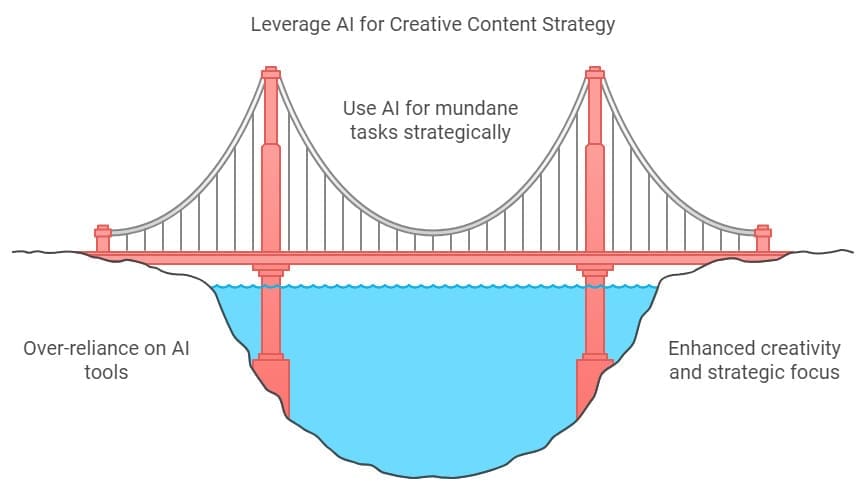
Leverage AI for Creative Content Strategy
Ways to Leverage AI Effectively
- Automate Routine Tasks: Use AI to handle repetitive tasks like scheduling posts or responding to FAQs.
- Enhance Your Research: Utilize AI tools for market research to identify what topics are trending in your industry.
- Optimize Content Distribution: Use AI to analyze which platforms yield the best engagement and focus your efforts there.
The Collapse of the Content Creation Landscape
The content creation landscape is changing rapidly, with AI tools flooding the market. This shift can feel overwhelming, especially for small business owners like you who are trying to navigate these waters. As AI-generated content continues to rise, the challenge will be to maintain a competitive edge.
Understanding this landscape is crucial. It’s not just about creating content anymore; it’s about creating meaningful, engaging, and authentic content that resonates with your audience. As you adapt to these changes, remember that the human element in your content is irreplaceable.
By focusing on quality, authenticity, and strategic use of AI, you can not only survive but thrive in this evolving content landscape. Your unique voice and perspective are what will ultimately set you apart from the competition.
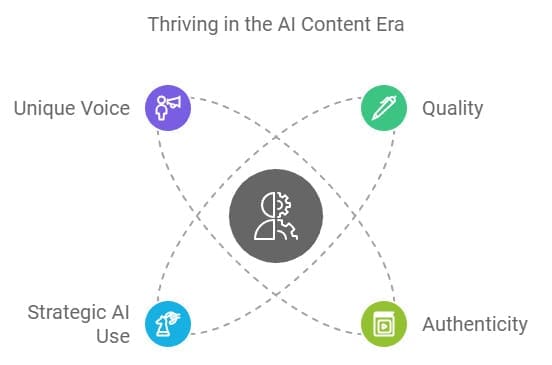
How to thrive in the AI content era
Revisiting the Inbound Marketing Revolution
Let’s take a moment to revisit the concept of inbound marketing, which revolutionized how small businesses approach content creation. Back in the early 2010s, the idea was simple yet powerful: produce valuable content that attracts customers to you. The belief was that by publishing blog posts, guides, and resources, you could draw potential clients in, establish authority, and build lasting relationships.
However, as the digital landscape evolved, the influx of content—much of it produced with AI—has caused the original principles of inbound marketing to become diluted. The challenge now is to not just create content but to create content that truly resonates with your audience amidst a sea of generic, AI-generated material.
Shifting Focus from Quantity to Quality
As small business owners, it’s time to pivot from the quantity-over-quality mindset that has taken hold. Instead of churning out blog posts to keep up with the competition, focus on delivering unique insights and perspectives that only you can provide. This shift not only improves engagement but also positions you as a thought leader in your niche.
The key takeaway? Inbound marketing is still relevant, but its execution needs to adapt to the current climate. Quality content that offers real value will always attract clients, even in a crowded market.

Focus on quality content over the quantity
The Gold Mine of Quality Content
Quality content is more than just words on a page; it’s a strategic asset that can drive traffic, increase engagement, and ultimately lead to conversions. In a world flooded with AI-generated content, your unique voice and perspective become your greatest assets. Here’s how to mine that gold effectively.
Understanding Your Audience
Before you create content, take the time to understand your target audience. Who are they? What are their pain points? What do they value? By answering these questions, you can tailor your content to meet their specific needs, making it more engaging and relevant.
Crafting Compelling Stories
One of the most effective ways to connect with your audience is through storytelling. Share your journey as a small business owner—the challenges you’ve faced, the lessons you’ve learned, and the successes you’ve achieved. This not only humanizes your brand but also creates an emotional connection with your audience.
Utilizing Data and Insights
Leverage data to inform your content strategy. Use analytics to understand which topics resonate with your audience and adjust your content accordingly. This data-driven approach ensures that your efforts are aligned with what your clients actually want to see.
Strategies for Creating Unique and Engaging Content
Creating engaging content requires a blend of creativity, strategy, and authenticity. Here are some actionable strategies to help you stand out in a saturated market:
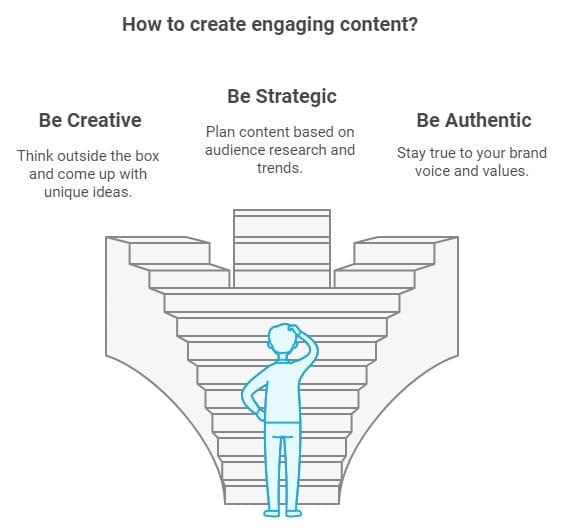
This is how to create engaging content.
1. Be Authentic
Your authenticity is your unique selling proposition. Share your real experiences, opinions, and insights. Don’t be afraid to show vulnerability; it builds trust with your audience.
2. Engage with Your Audience
Encourage interaction by asking questions and inviting feedback. Respond to comments and messages to foster a community around your brand. This engagement not only builds loyalty but also provides valuable insights into what your audience is looking for.
3. Use Visuals
Incorporate visuals like infographics, videos, and images into your content. Visual content is more likely to be shared and can help convey complex information more clearly.
4. Repurpose Content
Maximize the value of your content by repurposing it across different formats. Turn a popular blog post into a video, a podcast episode, or an infographic. This not only saves time but also reaches different segments of your audience.
Becoming the Client Attraction King of Your Niche
To truly become the go-to expert in your field, you must strategically position yourself as a leader. Here are some tips to help you achieve that:
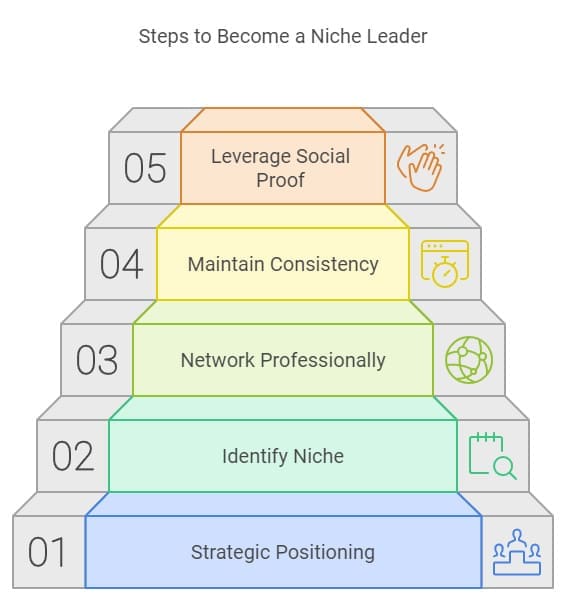
These are the Steps to Become a Niche Leader.
1. Identify Your Niche
Focus on a specific niche where you can provide the most value. This specialization allows you to tailor your content and marketing efforts, making it easier to attract the right clients.
2. Network with Other Professionals
Build relationships with other small business owners and professionals in your industry. Collaborate on content, share insights, and support each other’s efforts. Networking can lead to referrals and increased visibility.
3. Consistency is Key
Maintain a consistent posting schedule to keep your audience engaged. Whether it’s weekly blog posts, monthly newsletters, or daily social media updates, consistency builds trust and keeps your brand top-of-mind.
4. Leverage Social Proof
Showcase testimonials and case studies from satisfied clients. Social proof adds credibility to your brand and can significantly influence potential customers’ decisions.
FAQ: How Can I Effectively Integrate AI into My Content Strategy?
Integrating AI into your content strategy can enhance efficiency and creativity. Here are some frequently asked questions about this integration:
Q: What AI tools should I consider for content creation?
Look for tools that assist with brainstorming, data analysis, and content optimization. Tools like Grammarly for grammar checks and BuzzSumo for trending topics can be invaluable.
Q: How can I ensure AI-generated content aligns with my brand voice?
Always review and edit AI-generated content to ensure it reflects your unique voice and messaging. Use AI as a starting point, but let your personality shine through.
Q: Can AI help with audience analysis?
Absolutely! Many AI tools can analyze audience behavior and preferences, providing insights that can inform your content strategy. This data can help you tailor your messaging to better resonate with your audience.
Q: How do I balance AI use with personal touch?
Use AI for tasks like data analysis and idea generation, but make sure to infuse your content with personal stories and insights. The combination of AI efficiency and human creativity can lead to exceptional results.
By understanding how to effectively leverage AI while maintaining your unique voice, you can navigate the challenges of content marketing and position your business for success. Embrace the tools available to you, but always prioritize authenticity and connection with your audience.
